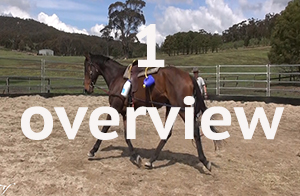
Off The Track Recycling - Overview
I call this the 'recycling' lesson - it is really introducing novel objects to the horse in a calm and controlled manner.
Training Information
Suitable for: All horses that are being started under saddle or have already been started.
Videos in course: 7
This series will show you how to introduce novel objects (the recycling bottles) to your horse without eliciting the flight response.
It is a wonderful lesson for 'cold-backed' horses as well - those horses that really aren't sure about the saddle or tend to buck under saddle.
Purpose
The purpose of this lesson is to habituate your horse to things around his saddle area. It is useful for horses that are in the process of being started under saddle and also those horses that have been started but are a little 'cold-backed' (humping or bucking under saddle or generally being uneasy when saddled).
The Basic Elements:
- The lesson introduces the objects (recycling plastic bottles) gradually to the horse in such a way as to habituate him step-by-step.
- This lesson, or lessons of this type (such as saddling itself) are often poorly carried out and result in a horse that bucks or is cold-backed. Often the reason is that the horse was simply 'flooded' with the information (in this case the bottles or the saddle) and the lesson was not broken down so that the horse could learn each step sequentially.
- Flooding, for example, throwing the saddle on the horse and letting him 'buck it out' often results in injury to the horse and always elicits fear, the flight response and a very high emotional level.
- None of this is necessary when we break the lesson down and teach it to the horse step-by-step.
Pattern
- The horse is introduced to the objects one at a time on the various saddle sites.
- The objects are weighted to ensure safe release if necessary.
- Both sides of the horse are addressed in the same way.
- The objects are tied to the saddle only when the horse has habituated to them sufficiently.
- A total of 4 objects (plastic recycling bottles) are used.
- The horse is long-reined carrying the bottles and remains attentive, in frame and soft in the bridle.
Prerequisites
Essential
Bridling
Give to the Bit
Long-reining
1st Saddling
See the Resources section for all of the above.
Useful
Round Pen
Timing
The lesson should take about 30 minutes.
Things to Remember:
- This is about 'educating' your horse. You are not trying to 'get him over' something or 'let him work it out for himself'.
- Watch for signs of stress, fear and raised emotional level. If you see any then go back a step or two because it is a sure indication that you have gone too far too fast.
- Look at the horse in the video and make a note of his emotional level and the changes in that throughout the lesson. We want the horse to be engaged - listening, learning and involved but never fearful or frightened. At the other end of the scale we want the horse engaged - not plodding about thinking of something else (here again, just as when he is afraid, he is not learning). We need to find the Engagement Zone.
ISES Training Principles:
- Release the pressure immediately when the horse responds. The pressure here, in the beginning, is simply the presence of the object. When the horse stands still (in the first part of the lesson) remove the object = release the pressure.
- Use signals that the horse can differentiate. Later in the lesson be clear with your horse. You should have well established verbal cues for walk and trot when long-reining.
- Train and initiate responses one at a time (shaping). We are not going to tie the objects to the horse and let him go! Just the opposite. The lesson is broken down into the smallest possible steps and each builds on the last until the horse has been properly habituated to the objects.
- Train habitual responses using consistency and repetition. Be sure to repeat exactly the same process on each side of the horse. The horse in the video is a lovely example of what goes wrong when we aren't consistent.
- Train only one response per signal. The signals that your horse will be receiving towards the end of the lesson will be those 'go forward', 'turn' and 'stop' signals that were installed in the 'Prerequisite' lessons.
- Avoid fear during training. This is paramount in this lesson. Sadly, many horses have been put through terrifying first saddling lessons and I am sure others have had things tied to their saddles and let loose to 'work it out'. This lesson is the opposite of that so look out for any signs of fear in your horse and go back a few steps if you feel you see something.
- Train persistence of responses. The horse is learning a pattern - ignore the objects and get on with what is being asked - in this case give to the bit, softness in the bridle, travel in frame, turn, stop and go with the long-reining.
- Check for relaxation. It is so important that the horse is relaxed and calm. If you see any conflict behaviours, such as a raised head and neck, raised tail or feet, disengaging the hindquarters, moving too fast and so on then go back a few steps. The horse will NOT learn if he is not relaxed.
 ISES Training Principles Poster
ISES Training Principles PosterDownload your copy of the International Society for Equitation Science's (ISES) Training Principles Poster here.
 ISES Code of Conduct
ISES Code of ConductDownload your copy of the International Society for Equitation Science's Code of Conduct. Parts of this document are particularly applicable to those of you that compete or hold events.
